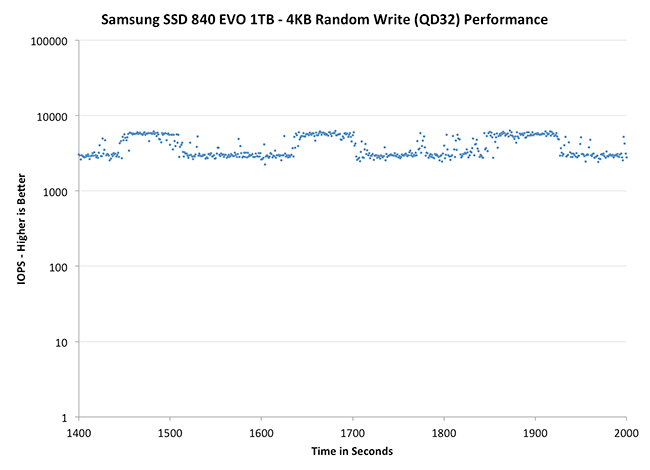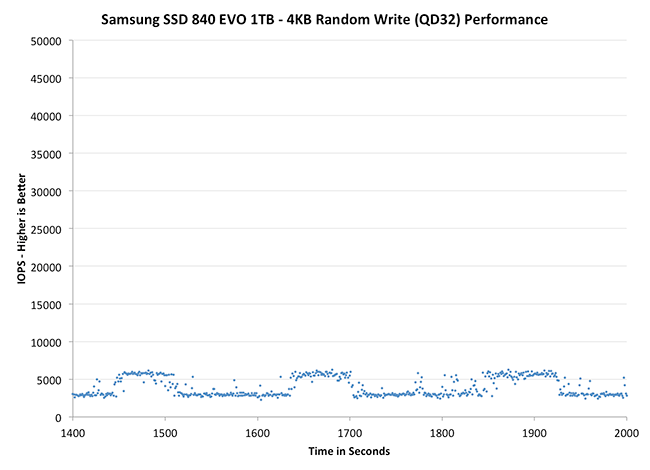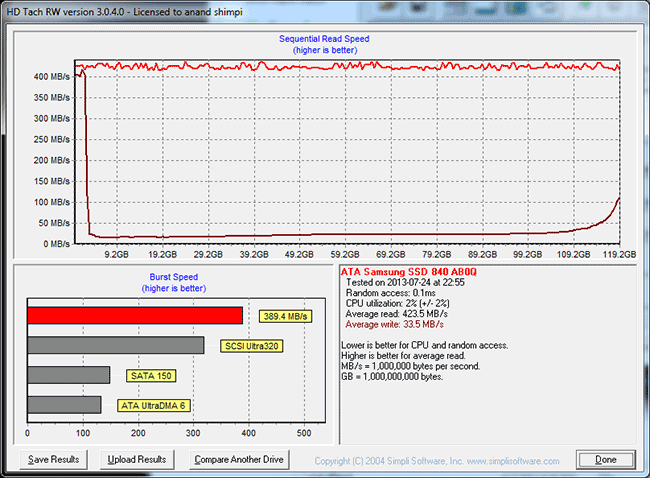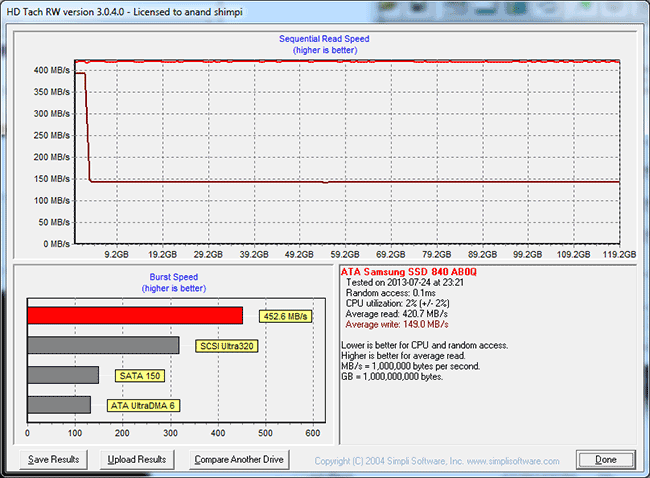Samsung SSD 840 EVO Review: 120GB, 250GB, 500GB, 750GB & 1TB Models Tested
by Anand Lal Shimpi on July 25, 2013 1:53 PM EST- Posted in
- Storage
- SSDs
- Samsung
- TLC
- Samsung SSD 840
Performance Consistency
In our Intel SSD DC S3700 review I introduced a new method of characterizing performance: looking at the latency of individual operations over time. The S3700 promised a level of performance consistency that was unmatched in the industry, and as a result needed some additional testing to show that. The reason we don't have consistent IO latency with SSDs is because inevitably all controllers have to do some amount of defragmentation or garbage collection in order to continue operating at high speeds. When and how an SSD decides to run its defrag and cleanup routines directly impacts the user experience. Frequent (borderline aggressive) cleanup generally results in more stable performance, while delaying that can result in higher peak performance at the expense of much lower worst case performance. The graphs below tell us a lot about the architecture of these SSDs and how they handle internal defragmentation.
To generate the data below I took a freshly secure erased SSD and filled it with sequential data. This ensures that all user accessible LBAs have data associated with them. Next I kicked off a 4KB random write workload across all LBAs at a queue depth of 32 using incompressible data. I ran the test for just over half an hour, no where near what we run our steady state tests for but enough to give me a good look at drive behavior once all spare area filled up.
I recorded instantaneous IOPS every second for the duration of the test. I then plotted IOPS vs. time and generated the scatter plots below. Each set of graphs features the same scale. The first two sets use a log scale for easy comparison, while the last set of graphs uses a linear scale that tops out at 40K IOPS for better visualization of differences between drives.
The high level testing methodology remains unchanged from our S3700 review. Unlike in previous reviews however, I did vary the percentage of the drive that I filled/tested depending on the amount of spare area I was trying to simulate. The buttons are labeled with the advertised user capacity had the SSD vendor decided to use that specific amount of spare area. If you want to replicate this on your own all you need to do is create a partition smaller than the total capacity of the drive and leave the remaining space unused to simulate a larger amount of spare area. The partitioning step isn't absolutely necessary in every case but it's an easy way to make sure you never exceed your allocated spare area. It's a good idea to do this from the start (e.g. secure erase, partition, then install Windows), but if you are working backwards you can always create the spare area partition, format it to TRIM it, then delete the partition. Finally, this method of creating spare area works on the drives we've tested here but not all controllers may behave the same way.
The first set of graphs shows the performance data over the entire 2000 second test period. In these charts you'll notice an early period of very high performance followed by a sharp dropoff. What you're seeing in that case is the drive allocating new blocks from its spare area, then eventually using up all free blocks and having to perform a read-modify-write for all subsequent writes (write amplification goes up, performance goes down).
The second set of graphs zooms in to the beginning of steady state operation for the drive (t=1400s). The third set also looks at the beginning of steady state operation but on a linear performance scale. Click the buttons below each graph to switch source data.
 |
|||||||||
| Crucial M500 960GB | Samsung SSD 840 EVO 1TB | Samsung SSD 840 EVO 250GB | SanDisk Extreme II 480GB | Samsung SSD 840 Pro 256GB | |||||
| Default | |||||||||
Thanks to the EVO's higher default over provisioning, you actually get better consistency out of the EVO than the 840 Pro out of the box. Granted you can get similar behavior out of the Pro if you simply don't use all of the drive. The big comparison is against Crucial's M500, where the EVO does a bit better. SanDisk's Extreme II however remains the better performer from an IO consistency perspective.
 |
|||||||||
| Crucial M500 960GB | Samsung SSD 840 EVO 1TB | Samsung SSD 840 EVO 250GB | SanDisk Extreme II 480GB | Samsung SSD 840 Pro 256GB | |||||
| Default | |||||||||
 |
|||||||||
| Crucial M500 960GB | Samsung SSD 840 EVO 1TB | Samsung SSD 840 EVO 250GB | SanDisk Extreme II 480GB | Samsung SSD 840 Pro 256GB | |||||
| Default | |||||||||
Zooming in we see very controlled and frequent GC patterns on the 1TB drive, something we don't see in the 840 Pro. The 250GB drive looks a bit more like a clustered random distribution of IOs, but minimum performance is still much better than on the standard OP 840 Pro.
TRIM Validation
Our performance consistency test actually replaces our traditional TRIM test in terms of looking at worst case scenario performance, but I wanted to confirm that TRIM was functioning properly on the EVO so I dusted off our old test for another go. The test procedure remains unchanged: fill the drive with sequential data, run a 4KB random write test (QD32, 100% LBA range) for a period of time (30 minutes in this case) and use HDTach to visualize the impact on write performance:
Minimum performance drops down to around 30MB/s, eugh. Although the EVO can be reasonably consistent, you'll still want to leave some free space on the drive to ensure that performance always stays high (I recommend 15 - 25% if possible).
A single TRIM pass (quick format under Windows 7) fully restores performance as expected:
The short period of time at 400MB/s is just TurboWrite doing its thing.












137 Comments
View All Comments
Timur Born - Sunday, July 28, 2013 - link
Just did a quick test: On my 8 gb RAM system Windows 8 uses quite exactly 1 gb for write caching and all available RAM for read caching. It doesn't matter whether the 1 gb consist of one or several files and whether they fit into the cache as a whole or not (first 1 gb is cached if not).1Angelreloaded - Friday, July 26, 2013 - link
Hold on a second correct me if I'm wrong on this paradox. Did Samsung not scale back on NAND production in order to drive the price up for greater bloated profits, now as stated in Korea press conference they want "SSDs for everyone". WTF is going on here, and why are SSDs not at more reasonable pricing by now about .33cents per gig.?They had a complete shot at burying HDDs after the flood and the price hike.FunBunny2 - Friday, July 26, 2013 - link
Don't confuse capitalists with intelligence. They look at unit margin and ignore gross profit. IOW, they'd rather sell 100 at $2 margin than 1,000 at $1 margin. They're stupid.MrSpadge - Saturday, July 27, 2013 - link
There's also the factor of marget saturation to take into account. You can't sell an infinite number of drives.Notmyusualid - Friday, July 26, 2013 - link
Exciting technology indeed! Impressive numbers, nice identification of spare computer resources, and put to good use too. I'd imagine this would be the go-to drive for most users...But I'd like my clocks available for my applications thanks.
In addition, I'm not willing to put my data on any non-enterprise disk now, cost be damned. Burned too many times now.
Interesting product though....
z28dreams - Friday, July 26, 2013 - link
I recently saw the Plextor M5P (pro) for $190 on sale.If the 840 evo comes out in the same price range, which would be a better buy?
It looks like the write seems of the M5P are better, but I'm not about overall performance.
K_Space - Friday, July 26, 2013 - link
Help a noob here: How is Rapid any different to a custom nonvolatile RAM disk with your selected cached files stored on it & these being written to the SSD at an interval? Is it mainly because Rapid can writes in blocks and it's more intelligent in its choice of cached files?wpapolis - Saturday, July 27, 2013 - link
Hey there all,I have a MacBook 13" from late 2008, the first gen of the unibody construction (Model MB467*/A).
My bus speed is SATA 3Gbit/s.
What's the best SSD for me?
Trim doesn't work automatically for me, though I have found the commands to use in terminal to enable it.
This Samsung drives looks really good, but it seems like I won't be able to use RAPID, or perhaps even TRIM. Plus I am limited by my bus speed. Should I still go for this Samsung just because the price might be the same as lower featured alternatives?
What do you guys suggest? I want one in the 250GB range.
Thanks,
Bill
TheinsanegamerN - Saturday, July 27, 2013 - link
if you have a mac, the samsung is your best bet. TRIM can be enabled quite easily on a mac if it is not done automatically, so you can use trim. as for RAPID, it replaces window's terrible i/o caching process. osx does not have this problem, so you dont have to worry about that. now, the sata2 interface will be a bottleneck, but it will still be much faster than a hard drive. id go for either this evo drive or the 840 250gbwpapolis - Saturday, July 27, 2013 - link
Yes, you reaffirmed what I was already thinking.Plus, when I upgrade this MacBook, I have the option to move the drive. Though, I have to say, performance is still pretty good, but each OS upgrade seems to make things a bit more sluggish.
With 8GB RAM, and a current SSD, things should be good for a bit longer.
Thanks for the feedback,
Bill